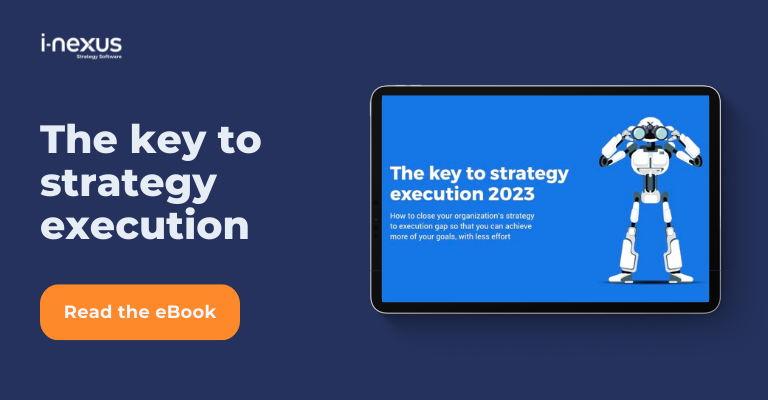Strategic Portfolio Management is becoming increasingly popular as more businesses look to optimize and improve their time to market, address their CAPEX, achieve their ESG targets, and realize their strategic goals - so what does it all mean?
Written by: James Milsom, Head of Marketing
Today's business climate is saturated with terms like agile, automation, strategy, and culture. Among others. That's because today's most successful businesses are changing the way they operate and stay competitive.
Research from McKinsey shows that one of nine strategic imperatives for companies to succeed is sharpening their value agenda.
In fact, they assert that "up to 95 percent of economic profit is earned by the top 20 percent of companies, any organization that isn't seeking new approaches is on borrowed time." This means companies need to identify and strategize how they create value, from organizational functions to customer support.
Strategic Portfolio Management is one way today's organizations can grow with agility and be prepared for any unexpected challenges or upheavals.
Today, we're going to run through the 101 on Strategic Portfolio Management, answering the key questions about what it is, what it takes to succeed, who is involved in the practice, and the roles of PMOs, EPMOs, and the SRO.
What is Strategic Portfolio Management?
Strategic Portfolio Management (SPM) is a way to connect organizational, strategic goals with the necessary steps to achieve them. It takes your strategic goals and places them in an operational context.
As the Project Management Institute says, SPM is "a way to bridge the gap between strategy and implementation."
It acknowledges that each decision made within an organization affects the organization as a whole, and there is a need to bring control, structure, and discipline to the many programs, people, and resources associated with achieving your goals.
Strategic initiatives (or portfolios) contain groups of plans (programs) developed to help the company to achieve any number of its goals, such as:
- Business transformation - taking your business on a transformation journey, with examples including digital transformation, cost reduction, CAPEX, and evolving functions such as HR, supply chains, and procurement
- Environmental, Social, and Governance - with the rise of sustainability, human rights, and global warming comes the need to focus businesses on reducing their carbon footprint, embracing LGBTQ+ and racial issues, for example
- Mergers and Acquisition - as markets intensify and acquisitions or mergers take place, there is a need to keep a firm grip on the control and visibility of synergy initiatives, cost savings etc.
- Private Equity Portfolio Management - private equity investors seeking to ensure their portfolio companies adhere to an operating or strategic system, for example, or simplify management reporting, can use SPM to introduce discipline to their efforts.
SPM helps keep these strategic initiatives on course.
What Is Involved In Strategic Portfolio Management?
No business runs on its own. It takes planning and execution to reach organizational goals.
To develop a strategic portfolio management plan, portfolio managers need to identify the goals and objectives of the organization, and determine the best things to focus on, such as the above, moving forward to achieve them.
Building out a portfolio of strategic programs, therefore, is central to a business' ability to hit its targets.
That makes it necessary to evaluate strategic progress. That means asking what is working - and what is not - within the company, and deciding if anything should be changed, started, revisited, or eliminated altogether.
Who Is Involved In Strategic Portfolio Management?
Generally, upper or senior management oversees strategic portfolio management decisions.
Stakeholders are keenly aware of the goals and objectives of their organizations, so it falls to them to be responsible for it.
The strategic portfolio, therefore, is likely to be managed centrally by something known as a Strategy Realization Office / Strategy Office.
SPM bridges the gap between strategy and implementation
Differences between PMOs, EPMOs, and SROs
Within many organizations, there are PMOs: Project Management Offices and Program Management Offices, as well as Portfolio Management Offices. While these roles each have importance in reaching company-wide goals, they are not the same.
The Project Management Office monitors specific projects and assists project managers in completing specific tasks related to their projects.
Program Management Offices deliver information and data to project managers, program managers and portfolio managers, to help them achieve success with their projects. They will also share reports and data with senior management, to keep them up to speed on how the organization is doing.
Portfolio Management Offices are more strategic in their responsibilities, ensuring the projects and programs within the organization are aligned with the goals and objectives of the company.
Enterprise PMO (EPMO), however, considers the roles of all PMOs, as well as the goals of senior management. While PMOs are ensuring things are done right, EPMOs work with stakeholders to determine the right things are being done, and address issues from a more executive level.
And then there is the SRO. The SRO and EPMO are likely to have the responsibility of managing the delivery, reporting, and optimization of the portfolio.
That requires Chief Strategy Officers, Heads of Strategy, and Strategic Planning Managers to work in lockstep with key stakeholders to feed information and actions in and out of what is, essentially, the central nervous system of the corporate strategy. And naturally, that requires software that supports bi-directional functionality to close the loops between strategy and day-to-day work.
How Does SPM Relate To Program And Project Management?
Simply put, strategic active portfolio management assists with program project management by ensuring they have the right tools, data, information, and other crucial aspects for the success of their efforts.
What Are The Challenges Of Strategic Portfolio Management?
SPM has many moving parts, which means action plans, reports, directives, and data can sometimes get lost in the wrong places.
So, once your strategic portfolio has been developed, it's crucial to have a way to keep it active and on track, with the right people. That's where software like i-nexus helps.
Other challenges with strategic portfolio management include:
Lack Of Knowledge
Strategic Portfolio Management is a relatively new practice for today's organizations, so it's challenging to implement a strategic portfolio management policy without the right education around how to do it most effectively, such as our eBook.
Lack Of The Right Tools
All jobs need the right tools to be done the best, and SPM is no different.
If the SRO / EPMO is lacking the right technology, information, data, and resources, it certainly makes effective SPM difficult. Set your organization up for success, and that means the right processes, tools, and software.
Implementation
As with any strategy, project, campaign, or program, implementing strategic portfolio management can be tricky without the right people, tools, and processes in place.
That is why organizations look to different strategic methodologies, such as Hoshin Kanri / Policy Deployment, with its clear planning (x-matrix and catchball), executing (action plans and program management), and tracking (KPI bowling chart) tools, which bring rigor into their SPM.
And beyond that, it is not uncommon to find organizations putting to use mechanisms such as a prioritization framework and matrix to help with the difficult decisions around continuing or ceasing programs.

Strategic Portfolio Management Concept
What Are The Benefits Of A Successfully Executed Strategic Portfolio?
Developing a fantastic strategic portfolio is just one part of the process.
Many strategic portfolio plans go wrong simply due to ineffective implementation. However, the benefits of a successfully executed strategic portfolio include:
- A strong bridge between goals and actions
- Company-wide involvement in achieving objectives
- Proper governance of processes, procedures, and policies
- A clear picture of everyone's role within the strategic planning
- Improved company culture and increased productivity
Best Practices For Managing A Strategic Portfolio
To stay competitive, today's organizations need to understand how to manage a strategic portfolio. These steps are just some ways to do so successfully.
Identify The Goals
Having clear goals creates a roadmap to achieving them.
Take An Honest Approach
Before developing the portfolio, leaders need to take an authentic, honest look at their organizational structure to identify weaknesses and strengths. Doing so means you'll be able to truly gauge the chances of success.
Use The Right Tools and People
Agile business management requires adopting the right technology and tools to get jobs done as efficiently and correctly as possible. The same goes for the human capital within your company. Ensure you have the right people doing the right things.
Best Tools For Managing A Strategic Portfolio
Traditionally, managing a strategic portfolio involved multiple processes and software.
Today, however, organizations leverage the flexibility and simplicity of software solutions like i-nexus, along with templates and other tools that streamline the process and enhance operations.
Integrations with software like PowerBI or project management software further simplify the process and connect each working cog within it, feeding the right information back into the SRO / EPMO, and providing real strategic and operational alignment.
Learn More About Strategic Portfolio Management
Click here to learn more about the role of SPM in executing your strategy or take a look at these content recommendations:
- Leading Strategy Execution: Strategy Execution comes with great responsibilities and that calls for an even greater leader. Strategic leaders are the captain of your organizational ship and this is why they are central to the vessel’s journey.
- The Key To Strategy Execution: Read our eBook to help you with implementing a new strategic portfolio management plan, with advice on how to execute your plan successfully and avoid common mistakes.
- Help Your Business Become Agile: Discover why an adaptive approach to strategic planning and execution begins with Operational Excellence.
About the author
James Milsom is Head of Marketing at i-nexus. James has wide-ranging experience in markets such as telecommunications, energy, education, and software.
As Head of Marketing, his drive is to raise awareness and understanding of the challenges facing enterprises in delivering strategic objectives and transformation amidst changing markets and the obstacles traditional tools and methods present leaders.
If you’d like to talk more about Strategy Execution, reach out to James on james.milsom@i-nexus.com or connect with him on LinkedIn for the latest insights.




